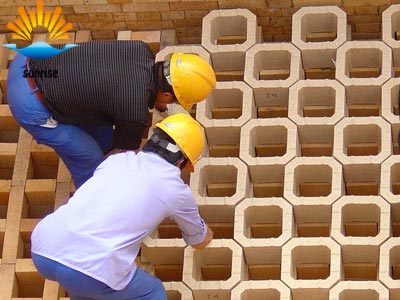■ Feature
►Specifications:
1.Magnesia Brick Refractory
2.CCS:60mpa,RUL:1700
3.Good erosion resistance
4.High quality
5.Reasonable price
Excellent strength of pressure bending, abrasion proof
Excellent performance of high-temperature firing, high rates of associative property, anti-erosion ability
Excellent thermal shock resistance and spalling resistance
Excellent ability of high refractoriness, anti-erosion of alkaline residue;
High temperature load of refractoriness under load. High mechanical strength
High temperature resistance excellent corrosion resistance
Resistance to spalling
It is basic refractory which the main phase is periclase. The product has such characteristics as high temperature resistance. Good slag resistance. strong corrosion resistance and steady volume in high temperature.
1.Magnesia Brick Refractory
2.CCS:60mpa,RUL:1700
3.Good erosion resistance
4.High quality
5.Reasonable price
►Magnesia Brick Features:
Excellent strength of pressure bending, abrasion proof
Excellent performance of high-temperature firing, high rates of associative property, anti-erosion ability
Excellent thermal shock resistance and spalling resistance
Excellent ability of high refractoriness, anti-erosion of alkaline residue;
High temperature load of refractoriness under load. High mechanical strength
High temperature resistance excellent corrosion resistance
Resistance to spalling
It is basic refractory which the main phase is periclase. The product has such characteristics as high temperature resistance. Good slag resistance. strong corrosion resistance and steady volume in high temperature.

►Application:
■ Technical Data
►Physical and chemical index:
| Item | MZ-91 | MZ-92 | MZ-93 | MZ-94 | |
| Chemical composition % | MgO ≥ | 91 | 92 | 93 | 94.5 |
| SiO2 ≤ | 4.0 | 3.5 | 2.5 | 2.0 | |
| Fe2O3 ≤ | 1.3 | - | - | 1.2 | |
| CaO ≤ | 2.5 | 2.5 | 2.0 | 1.8 | |
| Apparent Porosity% ≤ | 18 | 18 | 18 | 18 | |
| Bulk Density g/cm3 ≥ | 2.86 | 2.90 | 2.95 | 2.92 | |
| Cold Crushing Strength Mpa ≥ | 60 | 60 | 50 | 60 | |
| 0.2Mpa Refractoriness Under Load T0.6 ℃ | ≥1570 | ≥1560 | ≥1620 | ≥1650 | |
| Permanent Linear Change On Reheating(%)1500℃X2h | 0~+0.4 | 0~+0.4 | 0~+0.4 | 0~+0.4 | |
| Thermal Shock Resistances 100℃ water cycles | ≥18 | ≥18 | ≥18 | ≥18 | |
■ About Us
development history »

Factory strength »



Factory strength »

























